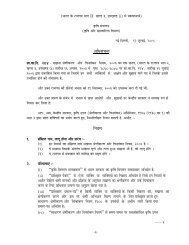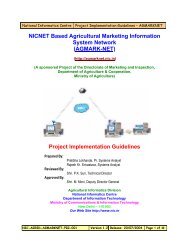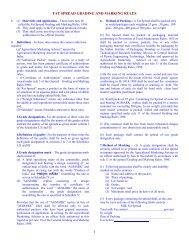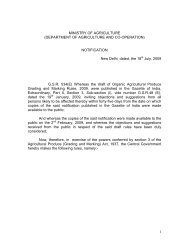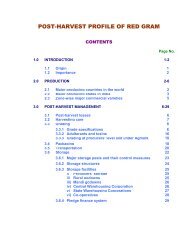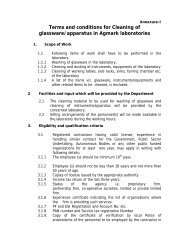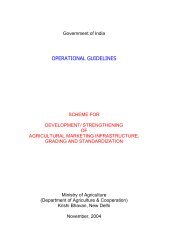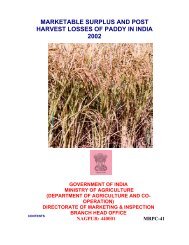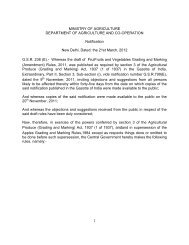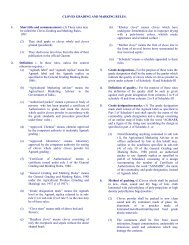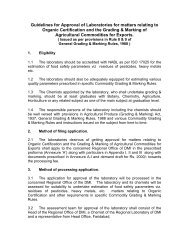Post - Harvest Management of Mushrooms with Special ... - Agmarknet
Post - Harvest Management of Mushrooms with Special ... - Agmarknet
Post - Harvest Management of Mushrooms with Special ... - Agmarknet
Create successful ePaper yourself
Turn your PDF publications into a flip-book with our unique Google optimized e-Paper software.
SUMMARY<br />
In Himachal Pradesh, the commercial production <strong>of</strong> mushroom<br />
started during late sixties on an experimental basis by<br />
Dr.E.F.K.Mantel, an Agricultural Scientist under FAO Programme.<br />
The College <strong>of</strong> Agriculture, Solan took the lead and provided<br />
initial research facilities. Sri Amarinder Singh was the pioneer<br />
grower to venture in the field. The raw materials used were<br />
wheat straw, spent brewer's grain from Solan distillery, wheat bran, super<br />
phosphate, murate <strong>of</strong> potash and urea. The spawn was provided by agriculture<br />
college, Solan, and spent mushroom compost, sand, saw dust and loamy soil<br />
formed the casings. Around early seventies some growers <strong>of</strong> Chail and Kasauli<br />
produced few hundred kgs. <strong>of</strong> mushroom per day which was canned by TEGS<br />
Mushroom.<br />
Oyster mushroom<br />
cultivation<br />
Button mushroom<br />
cultivation<br />
Himachal Pradesh emerged as a major state <strong>of</strong> mushroom cultivation<br />
where small growers, co-operative growers societies, big farmers and some<br />
corporate organisations are engaged in production. Since, it is an ideal state<br />
for development <strong>of</strong> mushroom industry, several commercial units in<br />
organised/corporate sector have come up in Himachal Pradesh. The major<br />
growing districts are Solan, Shimla, Kangra, Mandi, Kullu and Sirmaur. Due to<br />
improved quality <strong>of</strong> compost, better market facilities, small and medium sized<br />
units have been established around Shimla and Solan. However, some limiting<br />
factors such as inadequate financial facilities, high cost <strong>of</strong> transportation in hilly<br />
areas, inadequate post harvest infrastructure, rising cost <strong>of</strong> inputs are coming<br />
in way <strong>of</strong> expected progress.<br />
Increased productivity demands proper post harvest<br />
infrastructure to increase shelf life and marketability. Since<br />
mushrooms are perishable and delicate in nature, these cannot<br />
be kept afresh for more than 24 hrs. After the maturing <strong>of</strong> the<br />
fruiting body, the deterioration starts <strong>with</strong> the formation <strong>of</strong><br />
brown colouration and hence the quality deterioration and loss<br />
<strong>of</strong> marketability. To overcome this problem, specially during<br />
peak season, suitable post harvest management/practices are<br />
to be followed to increase the shelf life and marketability <strong>of</strong><br />
mushrooms. Initial steps are, proper harvesting time and<br />
stage. <strong>Mushrooms</strong> are generally harvested after 3 weeks <strong>of</strong><br />
casing. Button mushrooms are to be harvested when the CAP<br />
<strong>Harvest</strong>ing <strong>of</strong><br />
mushroom<br />
size is 30-45 mm in diameter, whereas Oyster mushroom is harvested when<br />
the fruiting body becomes curled under edges and well formed gills.<br />
1




